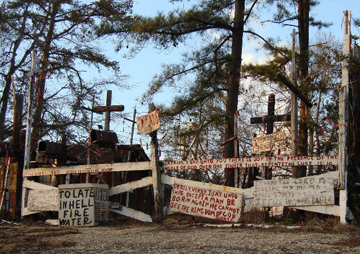
W.C. Rice, "Cross Garden," Prattville, AL. Image courtesy of and copyright: https://www.deepfriedkudzu.com/
In 1974, the Walker Art Center in Minneapolis launched the exhibition Naives and Visionaries, showcasing nine artists whose work manifested itself through artistic environments, both secretive and public. Martin Friedman guest curated the show with Gregg Blasdel who, six years earlier, sounded the wake-up call to this genre of art in his October 1968 Art in America article “The Grass-Roots Artist.” While Americans had long witnessed the idiosyncratic creative expressions of art along the highways and back roads of the United States, for the most part, anyone who publicly stepped outside of the accepted neighborhood norm was dismissed as “oddballs or eccentrics.”
We’ve come a long way since then. Then again, we haven’t. Two steps forward and one step back will move one along, but it is slow-going. Even today, many cities in America have neighborhood building codes designed to squash the eccentric individualist for something as benign as the “wrong” color on his or her house.
Still, it is the courage of such nonconformists, with their fearless individualism and occasional obstinate behavior, who give us ordinary homeowners a bit more backbone to color outside the lines.
Not withstanding the common “bathtub Madonna“ found in neighborhoods populated by Catholics, some of the most famous art environments have been influenced by a desire to serve Christ in the form of hand-constructed grottoes or shrines. While most religious grottoes have a certain tradition in the form of materials used in their construction (encrusted concrete, shells, colored tiles, rocks and glass), they are considered, even by non-Catholics, as sacred spaces, designed to rejoice with the already converted.
The flip side of this would be the evangelical Christian sites, which are more in-your-face roadside attractions, designed to convert the non-believers and shout the word of God like a Southern evangelical tent preacher. Take the Rev. W.C. Rice (1930 – 2004), for example, who filled his acreage in Prattville, Alabama with apocalyptic religious warning signs like “Hell is Hot” and “Sex Pit: Help Me Jesus!” On a visit to his “Miracle Cross Garden” in 1999, I evaluated Rice as a harmless zealot, and his “art” (painted religious rants on scores of hand-built crosses, plywood, and even hoods of junk automobiles) was more a by-product of his religious fervor than that of artistic intentionality. Sad to say, Rice was a sideshow freak to many visitors.
Many self-taught artists, uncontaminated by art school instruction, rely on intuition as their guide. While not immune from the dogma of the church, politics, or the immersion of popular culture in everyday life, many of these individuals follow a personal path known only to them.
Emory Blagdon (1906-1986) lived alone in the Sand Hills of central Nebraska. As close to isolation as one can imagine, Blagdon worked a good portion of his adult life creating what he called his “healing machines.” When his work was first witnessed hanging from the rafters of an 800-foot shed, it was the beginning of a major discovery in the world of self-taught art. Like a freshly opened geode, the inside of that secret environment must have been something to behold with its hanging elaborate constructions of twisted copper wire, metal shards, old Christmas lights, aluminum foil, painted wood, and other found detritus. Blagdon believed his complex, web-like “machine” could conjure healing powers from electromagnetic and other unknown forces. Today, much of Blagdon’s environment now resides at The Kohler Art Center in Sheyboygan, Wisconsin. His art was a marvelous collision of imagination and science, regardless of its flawed theories.
When looking at the question of outside influences in art making, one must explore not only religious influences but political, social, and chemical. The artist Alex Grey (b. 1953), who creates visionary paintings through his experimentation with LSD, is involved in a professional study of Eastern spirituality and Western pharmacology. It is this psychedelic insight that informs and drives his work today.
Missouri self-taught artist Jesse Howard (1885 – 1983), who lived to be 98 years old, was affected by two influences in his life, religious fervor and politics. Opinionated and cantankerous, Mr. Howard expressed his First Amendment viewpoints by painting signs—lots of them. His entire acreage was covered in his hand lettered signs and banners, with rants ranging from local politics to national issues to Biblical verse. While locals plotted ways to have him committed, Jesse Howard went right on painting signs and posting them on his fence, house, and barn. He wasn’t about to stop:
John Foster contributes a regular column for Design Observer called Accidental Mysteries, and is a longtime collector of self-taught art and vernacular photography. He works for TOKY Branding + Design in St. Louis, MO.WHAT IS GOING ON BEHIND THE IRON CURTAIN IN FULTON. MO? I HEARD SOME MEN SAY THAT GOVERNOR HEARNS’ IS SO STUPID.’ IGNORANT THAT HE DOES; NOT KNOW WHAT IS GOING ON WITHIN 25 MILES OF HIS MANSION.




